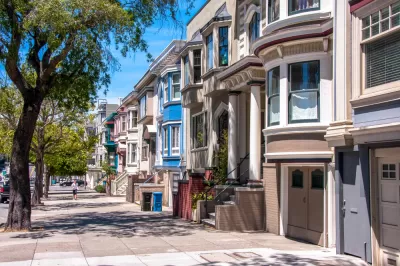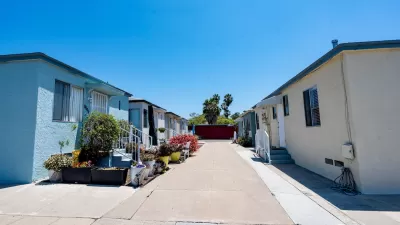As the housing crisis continues, advocates are increasingly wary of historic preservation efforts that serve to perpetuate historic inequities and keep housing costs high.

San Francisco’s St. Francis Wood neighborhood was just added to the National Register of Historic Places, making it much more difficult to build projects, reports Benjamin Schneider in the San Francisco Examiner. Housing advocates decry the move as a NIMBY action to prevent development in the area.
The historic designation makes the neighborhood exempt from SB9, SB10, and SB35, all state bills that allow for higher-density construction in an effort to alleviate the state’s housing crisis and undo decades of exclusionary and racist policies. “If you are preserving structures with the requirement that they remain single-family homes forever, when the origin of that single-family home was so Black people and Japanese people and Chinese people could not live there, is that really what you want to preserve?” asks Annie Fryman, a housing policy expert working for Abodu.
Activists worry that more communities will follow suit. “Already, wealthy communities from Palo Alto to Pasadena have tried to skirt SB 9, the statewide duplex law, by creating historic districts.”
“Fryman thinks there could have been a middle ground where the streets, parks and monuments of St. Francis Wood could have earned a historic designation but not the houses, which she describes as a ‘jumbling and sort of incoherent mix of 25 disparate revival styles.’”
While Fryman acknowledges that all neighborhoods can be precious to their residents, “If we historically preserve every neighborhood in San Francisco, we will be taking an enormous step backward, both in terms of equity and racial outcomes, and our housing crisis.”
Related Stories:
FULL STORY: St. Francis Wood earns historic designation, sparks backlash

Alabama: Trump Terminates Settlements for Black Communities Harmed By Raw Sewage
Trump deemed the landmark civil rights agreement “illegal DEI and environmental justice policy.”

Planetizen Federal Action Tracker
A weekly monitor of how Trump’s orders and actions are impacting planners and planning in America.

How Atlanta Built 7,000 Housing Units in 3 Years
The city’s comprehensive, neighborhood-focused housing strategy focuses on identifying properties and land that can be repurposed for housing and encouraging development in underserved neighborhoods.

In Both Crashes and Crime, Public Transportation is Far Safer than Driving
Contrary to popular assumptions, public transportation has far lower crash and crime rates than automobile travel. For safer communities, improve and encourage transit travel.

Report: Zoning Reforms Should Complement Nashville’s Ambitious Transit Plan
Without reform, restrictive zoning codes will limit the impact of the city’s planned transit expansion and could exclude some of the residents who depend on transit the most.

Judge Orders Release of Frozen IRA, IIJA Funding
The decision is a victory for environmental groups who charged that freezing funds for critical infrastructure and disaster response programs caused “real and irreparable harm” to communities.
Urban Design for Planners 1: Software Tools
This six-course series explores essential urban design concepts using open source software and equips planners with the tools they need to participate fully in the urban design process.
Planning for Universal Design
Learn the tools for implementing Universal Design in planning regulations.
Jessamine County Fiscal Court
Caltrans
Institute for Housing and Urban Development Studies (IHS)
City of Grandview
Harvard GSD Executive Education
Toledo-Lucas County Plan Commissions
Salt Lake City
NYU Wagner Graduate School of Public Service





























